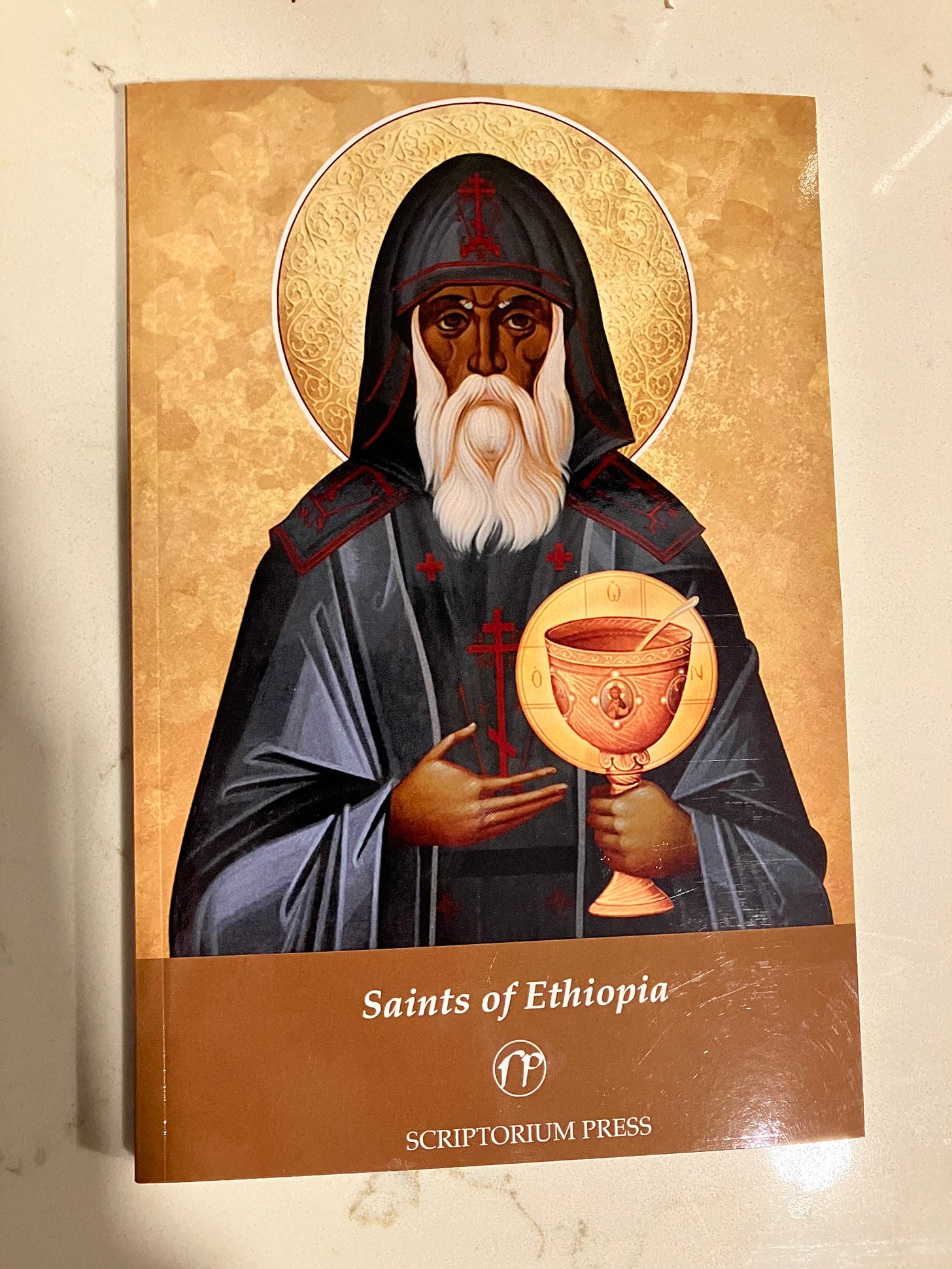The Bible begins with the curse and ends with the blessing. This is diametrically opposed to how the world operates. The world tells you the good news first, and leaves a bitter taste in your mouth by ending with the bad news. Be like the Bible.
I have many good things to say about Saints of Ethiopia, the recently self-published mini-synaxarium by Anthony Pavoni and Evangelos Nikitopoulos of Scriptorium Press. But I must begin with the bad. First, Pavoni and Nikitopoulos seem to understand a ton about Aksum and yet woefully conflate the loose and strict usages of the sometimes synonym Ethiopia. Secondly, they bring a putrid christological debate into what should otherwise be a simple book of saints that edifies believers.
“The word “Ethiopian” comes from Greek and literally means “one of burnt face.” The Greeks used this term indiscriminately to refer to any people of dark complexion… black demons are often described as “dark Ethiopians”... among classical authors it is not uncommon to find the term “India” used to refer to both India proper and to Ethiopia.”
I agree with this etymology, although there are some who dispute this. I trust Greeks to know Greek (Old and New). In the loosest sense, we have inclusivity of the human race and the demon race. In a slightly stricter sense we have large swaths of, if not all of, Africa, and the Indian subcontinent. As we get stricter we have the original Ethiopia aka Nubia aka Meroe, and we have Aksum who took this name by force and has LARPed as them ever since. A book entitled Saints of Ethiopia should stick with one definition of Ethiopia. This one defines it widely but then conflates it with stricter interpretations. As much as I love Saint Moses the “Ethiopian”, his life and sayings do not belong in a book on Aksum. If by Ethiopia we mean the widest possible definition, we should have seen at least one or two more from Nubia or India or perhaps the demon race.
The christological debate between and betwixt the Eastern Orthodox and the Oriental Orthodox, in superior parlance the Greek Orthodox and the Afroasiatic Orthodox, is exhausting enough to understand when you begin to dig into the history of the Council of Chalcedon. It is made all the worse in 2025 A.D. when two otherwise intelligent writers use the bad faith exonym Monophysite in lieu of the well-documented endonym Miaphysite. This is the polemical equivalent of me calling Greeks and Romans (Chalcedonians) Nestorians instead of Dyophysites.
See the Statement of the Orthodox Church of Antioch on the Relations between the Eastern and Syrian Orthodox Churches (November 12, 1991). See Miaphysite Christology: An Ethiopian Perspective by Fr. Mebratu Kiros Gebru. See The Council of Chalcedon Re-Examined by Fr. V.C. Samuel. See The Acts of the Council of Chalcedon by Richard Price and Michael Gaddis. See The Church Fathers taught Miaphysitism by Apostolic Orthodoxy. Whatever you decide after all of this christological consumption, this debate does not belong in the introduction of a book of saints. It has a time and a place amongst hierarchs of the Orthodox Church deciding to stay apart, or seeking renewed fellowship with one another at the table of the Lord.
Finally, I wish they did not include the Cannibal of Qemer. The Princeton Ethiopian, Eritrean, & Egyptian Miracles of Mary Project, where my son’s godfather and friend of the show Dr. Mehari Worku has contributed the overwhelming majority of translations, has a more recent translation than E.A.W. Budge (to whom we all owe an academic debt). And the hyperbole of the Cannibal’s trust in Mary seems admirable, but there is no clear-cut repentance for all of the souls he devoured (when he should instead have been devoured by zeal for the Lord’s house), and in general the holy synod of adees abeba has yet to go through and edit and release an official version of this book. Godwilling, they will do so thoroughly and soon.
The rest of what I have to say is pleasant. They open with Scripture:
Ambassadors shall come out of Egypt; Ethiopia shall hasten to stretch out her hands unto God.
(Psalm 67(68):32)
This Ethiopia, as I said earlier, or Kush in the Hebrew, is not Aksum, but that is okay, because this prophecy is functional. Scripture is a library of self-scathing and self-deprecating high culture literature written in the city against the city for the desert and the wilderness and the God thereof. One of the features of the self-critique is that Israel is not special. The blessings of salvation, rescue, and deliverance promised to them are extended to all adamites (groundlings). To the Gentiles (civilized but foreign), the Ethiopian (dark-skinned folks), and even the Scythian (pastoralist barbarians of the steppe). God is the god of all. Not just a ghetto in the Levant.
I cried reading all of the stories of the Saints of Ethiopia. Each one sucks you into the time and place, and makes you miss a country you never knew. The extended story of The Martyrdom of Saint Arethas and of the Christians of Negran is something I touched upon recently when I fed you Edward Gibbon, but hearing it again in narrative form had me bawling. The independent historian Thaddeus Russell (Columbia University Phd. and former professor at Barnard College) draws a link between Christianity and all of the foreign wars and entanglements of the United States Federal Government (USFG). I reject the interventionism of Neoconservatism and all of its works, but reading about these martyrs can turn a noninterventionist like me into an interventionist. In the end, Emperor Elesban (King of kings Kaleb) was canonized a saint (post-schism in the Roman Catholic Church and in the Ethiopian Orthodox Tewahdo Church) for coming to the aid of these Christians being slaughtered at the hand of an Arabian Jewish king, in turn “the Ethiopians set upon them and killed all the enemy”, and “Elesbas the king said that he was unable to render worthy thanks to God, but could think of doing only one thing, namely renouncing his kingdom and putting on the habit of the monastic life.” Where he endured his cell till death. It is hard for me to say I would do anything differently, and ultimately say Lord have mercy on me, a sinner, leaving my judgement to Jesus the Judge of the Living and the Dead.
The Life of Saint Jared the Melodist, or as I usually refer to my beloved patron saint, Saint Jared the Aksumite, also stuck out to me. It has my favorite river, the Tekezé. And it is filled with realistic humor. “He was of the same family as Abba Gideon, his teacher. From him Jared learned the Psalms of David, but as he was unable to commit them to memory, his teacher afflicted him severely with lashes.” St. Jared is a 6th Century saint. My own biological father went through these same Psalms of David in the same Ge’ez, or Classical Ethiopic, tongue, and received the same lashes from his first teacher, whether he did well or not. And so he later found a less abusive teacher who only hit him when he recited incorrectly.
“Now in those days there was no singing of hymns and spiritual songs in a loud voice to well-defined tunes, but men murmured them in a low voice, as the Egyptians are wont to do.” The EOTC says before Jared we used the wrd nibab (descending recitation) taught to children as they read 1 John, John, and the Psalms, and used extensively today on siqlet (crucifixion; Good Friday). The stray shot at the Egyptians got a chuckle out of me, but in context it makes sense. The Egyptians, Syrians, Armenians, and Indians were conquered many times over. Ethiopia can be said to have conquered herself through her embarrassing communist period, and ever since, but she has never been colonized by a foreign power. She has always retained her precious sovereignty. And thus, with the Eastern part of the Roman Empire falling in the 1400s, Aksum had 500 more years to develop the melodies of her sacred music. The melodies are said to have begun with Jared, but clearly they have changed over time, becoming ever more elaborate in tones and choreography.
The translations from Latin and Greek, transcription from English, and overall editing of this book are superb. I have come to be suspicious of the quality of editing of many self-published works, even when their content is great, but this book has both great content and great editing. I wish they would cut out the introduction and the cannibal, and advise any dear readers to skip these sections entirely, but the rest of the stories of the saints are worth more than their weight in gold.
Post Scriptum:
-I first read about King Kaleb in the Mises Institute, recommended to me by the back pages of Ron Paul’s End the Fed.
-Besides the fact that he is the son of an Egyptian (Greek Orthodox), the reason that Roman Catholic Jonathan Roumie (Jesus in The Chosen) was one of four executive producers to the film on the 21 Martyrs of Libya is because like King Kaleb they were canonized not only in the Coptic Orthodox Church but also in the Roman Catholic Church (RCC). There is also St. Gregory of Narek (an Armenian Apostolic or Orthodox), who was canonized not only a saint in the RCC but declared a Doctor of the Church by them. All three of these saints are post-schism (post-Chalcedon) saints. Act accordingly.






African Saints and Martyrs, pray for us! 🌍⛪☦️
I would love to see a book of common saints, saints held by all the Apostolic churches. Or, at least a list of saints who are shared by multiple communions... When I speak to my Catholic or Eastern Orthodox friends, I would like to be able to refer to some saints that we share.